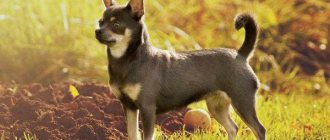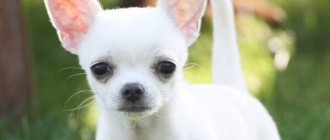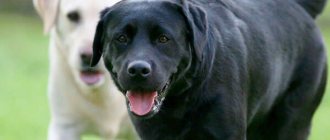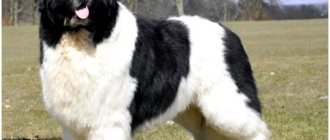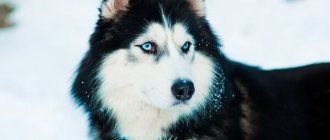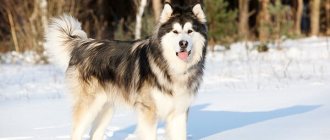Pure black coloring is rare in Chihuahuas.
Dogs with this coat color look very elegant, especially if they have a small white tie-like marking on their neck. But the most common Chihuahuas are black and tan.
But due to the fact that most breeders prefer to breed dogs of other, more fashionable colors, people who decide to get a black Chihuahua may have to spend a lot of time looking for a pet.
History of appearance
The first coal-black dogs were already found among the ancestors of the Chihuahua, called Techichi. These small, rather short-legged and stocky dogs, unable to bark, lived in Mexico back in the 15th century BC.
NOTE!
Techichi were bred by the Toltecs and were considered sacred animals. When in the 12th century AD. Aztec tribes came to these lands and ousted the Toltecs, the Techichi retained their status and began to be considered sacred among them. True, this was not always a good thing for dogs, since they were often sacrificed to the gods or buried with the deceased owner.
After Mesoamerica was conquered by the Spaniards, the Techichi found themselves in serious danger due to the fact that the Spaniards destroyed them during the destruction of Indian temples.
Several of these dogs managed to escape into the forest and hide there for several centuries. During this time, the Techichi, left to their own devices, interbred with each other, and possibly with other feral dogs. And when at the beginning of the 19th century several of these animals were caught and domesticated by local residents, they were no longer Techichi, but a completely different breed.
Among the dogs that were bred and later sold to foreign tourists by Mexicans were black dogs, which became the ancestors of modern black Chihuahuas.
Read more about the history of the Chihuahua here.
Training and education
Not all new breeders understand what they can do during the training process with a pocket dog. However, just because she is miniature in size, she does not cease to be an animal. Chihuahuas, like other living creatures, have a character. As you know, all domesticated dogs require special education. Otherwise, there is a possibility of raising a proud, uncontrollable animal.
So, raising a mini-Chihuahua is necessary in order to:
- Achieve obedience. This is the only way to prevent a dog from acting recklessly.
- Avoid escapes during periods of walking.
- Avoid injury. After all, the breed is predisposed to fights. Often the results of clashes are disastrous for small dogs. Unquestioning obedience to the owner will help your Chihuahua avoid unreasonable actions.
Training should begin according to the standard scheme. Usually, the basic program includes teaching the puppy such skills as: sit, voice, lie down, no, and others.
Also, from an early age you need to accustom your pet to a leash and collar. It is necessary to give the dog the opportunity to make independent decisions, but strictly suppress attempts to damage furniture or other interior items. Some Chihuahua owners are sure that climbing on the bed and damaging things are temporary difficulties, the pranks of little puppies. It seems to them that when the dog grows up, it will stop mischievousness. But this is a wrong opinion. If you don't stop your pet from crapping in time, it will become a habit.
A small dog needs socialization, so you need to introduce the Chihuahua to the outside world. You should not keep your pet at home all the time, even if it regularly goes to relieve itself in the litter box. If the owner goes on any trip, he is recommended to take the dog with him.
Marriage or breed?
Since all colors, except merle, are currently standard for Chihuahuas, a pure black color cannot be regarded as a defect in the breed.
Expert opinion
Kozhevin Semyon Kirillovich
Expert dog handler.
Black color is considered one of the main ones. Black Chihuahuas can be carriers of any other gene and such dogs are convenient for breeding. But you need to remember that a black Chihuahua, which is a carrier of chocolate or red color, may have a brownish tint to its coat, and in some cases even look dark brown. Such a dog, in addition, may have an undercoat of a different color - grayish or light fawn, which is especially noticeable in long-haired dogs.
White Chihuahua puppies
Chihuahua is a common dog breed that is known almost all over the world. Decorative pets conquer exhibitions, take part in television shows, and star in films. The popularity of these miniature dogs is growing every day. Because of this, a large number of nurseries engaged in breeding are appearing. As breeders say, one of the main selection criteria is coat color. So, among the popular colors is pure white. However, finding a puppy with a similar appearance feature is not so easy.
Advantages and disadvantages
Pros:
- look elegant and stylish;
- sociable and affectionate;
- distinguished by loyalty and devotion;
- they don’t need a lot of space in the house;
- if necessary, without hesitation they rush to protect the owner;
- sensitive and distrustful of strangers, which makes them good guards;
- willingly use the tray and diaper;
- easy coat care;
- love traveling;
- with the right approach they are easy to train.
Minuses:
- monogamous, tend to choose one owner;
- not suitable for families with children under 11-12 years of age;
- need very careful handling, as they have fragile bones and an open fontanel;
- may be jealous of the owner of other dogs and even children;
- they are cocky and do not get along very well with dogs of other breeds;
- an individual approach to training is needed.
IMPORTANT!
If not raised correctly, a black Chihuahua can grow up to be aggressive and even biting.
Dimensions, weight and other features
The height of a black Chihuahua does not exceed 23 cm, and its weight ranges from 0.5 to 3 kg. Standard size dogs weigh between 1.5 and 3 kg.
This is a small, elegant and proportional dog of approximately square format.
The head is apple-shaped, the stop is clearly visible, the muzzle is not too long.
The ears are erect, triangular, and widely spaced.
The eyes are large, round and expressive, and their most preferred color is dark brownish.
The color of the nose is black.
The neck is elongated, similar to that of a deer. The back is straight, the croup is slightly sloping. The chest reaches the elbows, is wide and quite voluminous.
The forelimbs and hind limbs are straight, and the hind limbs are slightly longer and slightly pulled back.
The tail is of medium length, set rather high, not docked.
The color of a black Chihuahua should be as rich as possible, and its coat should be shiny, well-groomed and clean. Small white markings are allowed.
What to feed?
Chihua Puppy with Wicker Baskets – “Developing Baby” – Go to the photo album page
The standard daily portion size for such a dog is calculated based on weight - up to 80 grams per kilogram of body weight. That is, in fact, this little dog eats only a few tablespoons a day. If the dog often walks, the norm may be increased. In addition, a particularly nutritious diet is necessary during the growth period, that is, until the age of 8-10 months.
It is necessary to maintain a balanced diet: 2/3 of the serving should be protein, and another 1/3 should be vegetable products. Despite its size, the Chihuahua still remains a predator by nature, so it may prefer raw meat to all other foods. But growth also requires other products - for example, special calcium supplements or low-fat cottage cheese and boiled eggs.
It will also be useful to give sea fish. All species are suitable except pollock. Due to the high content of active substances in pollock, it slows down the ability to absorb iron, which is why the dog can develop urolithiasis. The following are also prohibited:
- fresh cow's milk in dogs of this breed after 3 months of age can cause indigestion and diarrhea;
- nuts contain too much phosphorus, so their regular consumption provokes the leaching of calcium from the bones;
- all legumes (peas and soybeans) cause intestinal cramps and provoke flatulence;
- bell peppers can lead to an attack of gastritis;
- smoked meats, sweets and pickles cause disturbances in the function of the gastrointestinal tract and reduce metabolism (a dog can eat sweets with pleasure, and then it will be diagnosed with diabetes).
All foods from the “human table” are not suitable for dogs. They put too much stress on the pancreas and cause obesity.
Sometimes it happens that breeders immediately accustom the puppy to dry food. This is very convenient: you don’t need to measure the ingredients, monitor their calorie content, and so on. But keep in mind that not every food is suitable for this breed. The optimal choice is elite super or extra premium food. For example, Orijen (with a high protein content, up to 75% meat in the composition, suitable for pets with high physical activity) or Acana is suitable. Usually 60-80 grams of feed per day is enough, so the small consumption justifies the purchase of expensive granules. The use of dry food is justified for many reasons:
- all useful substances are already balanced in it;
- food can be left for the whole day and it will not spoil;
- When chewing the granules, plaque is removed.
But do not forget that when feeding dry food, there must be a bowl of fresh water nearby.
Breed varieties + photos
Smooth-haired
The coat is short, smooth, close-lying and shiny, and can be with or without undercoat.
Shorthair
Invalid coat type. Longer than smooth, but noticeably shorter than long-haired dogs.
Longhair
The coat is fine, long, soft, straight or slightly wavy, but not curly or downy. It forms beautiful fringes in the form of black fringe on the ears, as well as in the form of a collar on the neck and pants on the limbs.
Mini
Mini Chihuahuas differ from standard Chihuahuas in weight - it should not be less than 1 kg and not exceed 1.5 kg.
Micro
These black dogs can be considered one of the smallest breed varieties in the world - their weight is 0.5-1 kg.
NOTE!
Mini and micro Chihuahuas differ from standard ones not only in size, but also in slightly worse health and a shorter life expectancy.
Cobby
Black Chihuahuas of this type are characterized by such features as a strong physique, fairly good muscularity, a relatively large head with a strongly convex forehead and a short muzzle. Their eyes are dark, large, expressive and widely spaced. The ears are not too large, erect, triangular in shape, set rather low.
Dir
Chihuahuas of the Dir type look like figurines carved from ebony. They are elegant and very graceful. Their medium-sized heads with large, high-set ears and an elongated muzzle are very reminiscent of deer. The bones of these dogs are lighter than those of the Cobby, and the muscles are less developed.
Sellers' tricks
An honest breeder will immediately warn potential buyers about the possible health risks of a miniature Chihuahua and tell them how to avoid possible problems. Nor will he guarantee that the dog will not outgrow its expected height in the future. What will an unscrupulous breeder do? He will not say anything about the puppy’s health problems to future owners, even if he already has some ailments. On the contrary, it will assure potential buyers that this baby is completely healthy and he does not and cannot have any problems in this sense.
Some unscrupulous sellers deliberately underfeed standard Chihuahua puppies, which is why they hardly grow.
This is done in order to pass off the babies as minis and sell them at a higher price. However, this trick is not difficult to uncover. Real minis, although small, look quite well-fed. And underfed standard puppies are thin and look unkempt.
In addition, many dishonest breeders are in a hurry to sell the smallest puppies in the litter, before they catch up in size with their littermates. Therefore, you can often see advertisements for the sale of mini Chihuahua puppies that are only 1 - 1.5 months old. This is despite the fact that the minimum age at which it is permissible to sell puppies of even a standard Chihuahua is 3 months. Finally, there are also sellers who, taking advantage of people’s ignorance, simply sell them ordinary standard puppies under the guise of mini ones.
Life expectancy and health
The lifespan of standard representatives of the breed is on average 12-15 years.
In general, black Chihuahuas are in good health, but are predisposed to certain diseases :
- hypoglycemia;
- hydrocephalus;
- demodicosis;
- dislocated kneecaps;
- cataract;
- respiratory diseases;
- urolithiasis disease;
- diseases of the oral cavity.
Some dogs of this breed are also predisposed to allergies and dermatitis.
Tips for choosing a puppy
People who decide to buy a mini Chihuahua should understand that their pet's health will most likely be weaker than that of a standard dog of this breed. Therefore, it is very important to pay special attention to this issue at the stage of buying a puppy.
You only need to purchase mini Chihuahuas from a nursery. But even there, the breeder will not be able to guarantee that the baby will not grow to standard sizes. Even if a baby weighed less than his littermates at birth, this does not mean that he will not catch up with them in height and weight later. Therefore, the purchase of such a pet can be called a kind of lottery, since it is not known who will grow out of the puppy in the end: a mini Chihuahua or a standard dog of this breed. But at the same time, buying a miniature dog will most likely cost more than if it were a regular, standard-sized puppy.
Mini Chihuahua puppies, not only in Russia, but throughout the world, usually cost more than standard representatives of this breed.
Because of this, a paradoxical situation arises. After all, a mini puppy that will not be admitted to exhibitions and will not receive admission to breeding can cost the same as a standard show - or breed - class puppy. However, the fashion for pocket and “cup” dogs creates demand among potential buyers, and demand, as we know, creates supply. And so, people are already ready to overpay in order to, in the end, get not a show dog, but an outright breeding marriage.
And this is if they are lucky and the purchased puppy turns out to be at least relatively healthy and with a balanced psyche. In the worst case, buying mini and super-mini is fraught with the purchase of a sick puppy, the treatment of which will take a lot of effort, nerves and money.
Does a puppy's color change as it ages?
Most black Chihuahua puppies do not fade and retain their jet black coat color. An exception may be dogs that were born black, but later began to change color to sable. But they are noticeable almost immediately, since their coat color is not black, but rather brownish.
IMPORTANT!
Black Chihuahuas that carry the brown, red, or fawn gene may appear dark brown or brownish. In order to determine what color a dog is, just look at its nose - if it is brown, then the dog is chocolate. True black Chihuahuas will always have a black nose.
Color options
White Chihuahuas can have different color variations:
- pure white . Rarely seen and highly prized among breeders;
- two- color With this color, small colored spots are located on the main white background. Their color can be either black or red, which are quite common, or rarer shades - cream, blue, chocolate, lilac, sable, wolf, tiger;
- tricolor . Scattered across the white background are small spots of any other, darker color, complemented by a reddish polpalm;
- speckled _ White color with small specks of any darker shade.
Rules of care
For a smooth-haired black Chihuahua, brushing 2 or 3 times a week is sufficient. For long-haired individuals, daily combing with a comb is recommended.
There is no need to bathe Chihuahuas often, as these dogs get cold easily.
Your pet's eyes, ears, and teeth should be examined daily and cleaned as needed. To slow down the formation of plaque in your dog, you can let him chew on a toy or treat purchased at a pet store.
Nails are trimmed as needed using a nail clipper.
NOTE!
In the summer, before going for a walk, these dogs must be dressed in a light, light suit and a white or light-colored headdress placed on the pet’s head.
You can't do without clothes even in rain or cold weather. A black Chihuahua must have at least two overalls. One is made of waterproof fabric, for autumn, and the other is insulated, for winter.
Care and maintenance of the black chihuahua
There are no particular difficulties in caring for a dark Chihuahua. They need regular examination of eyes, ears, teeth, standard hygiene procedures and proper, balanced nutrition. Dogs need to be walked, taken care of their health and vaccinated.
Care for the coat, eyes and ears
A Chihuahua with short black fur is brushed three times a week. For long-haired species, the procedure should be daily using a comb. Regular grooming helps to increase blood circulation in the skin and saturate the hair follicles with nutrients.
Wet tear stains may form around the eyes of a sneezer. To prevent infection, they are treated daily with cotton pads soaked in boiled water or eye lotion. If purulent discharge and redness of the eyes appear, seek help from a veterinarian.
Once a month, dogs' ears are cleaned of dirt and excessive accumulation of wax. The procedure requires cotton pads, swabs and zoo lotion.
Feeding
The black Chihuahua can be fed both natural food and ready-made industrially produced pellets. For decorative dogs, choose high-quality premium, super-premium or holistic food. It is not advisable to buy “drying”, which contains wheat, corn, dyes and preservatives.
Dishes made from natural products should contain lean meat (poultry, beef, lamb), sea fish, cereals, cottage cheese, kefir, boiled eggs, vegetables and fruits. The content of protein products is at least 2/3 of the entire diet. It is unacceptable to feed Chihuahuas sweets, milk, baked goods, legumes, fried and fatty foods, and raw meat.
Training and education
Dark Chihuahuas are smart and quick-witted, they are able to learn commands quite quickly, but the process needs to begin at 2-3 months. Perseverance is required when learning. The result should be:
- Socialization - Chihuahuas cease to be dangerous to others.
- Education – the dog receives the skills to behave correctly.
- Training – the pet obeys the owner, follows his orders, and does not get into unpleasant and dangerous situations.
- Participation in competitions and exhibitions - the dog is friendly, restrained during contacts with judges and experts, and reacts adequately to other participants in events.
Bathing
It is not recommended to carry out water procedures until the Chihuahua reaches the age of 3-4 months. In the future, the pet is bathed once a month, and with shampoo - once every four months. More frequent procedures lead to seborrhea and hair loss. If you wash your Chihuahua once every six months or less, its fur becomes sticky and the risk of lichen, dermatitis and baldness increases.
The dog's paws are rinsed with warm water after each walk.
Walk
Despite the fact that black Chihuahuas can do without walking, you should not deprive them of such pleasure. They are taken out for a walk at air temperatures from -10 ⁰С to +30 ⁰С. In frostier weather, dogs can get frostbite, and in hot weather, when the temperature is above +30 ⁰C, heat stroke is possible, especially since the coat is black.
In the cold season, your pet will need overalls - waterproof for bad weather and warm for cold weather. In summer, Chihuahuas need a light suit made of natural fabric to protect them from overheating.
Diseases and vaccinations
The most common diseases diagnosed in Chihuahuas are:
- hydrocephalus;
- allergies;
- cryptorchidism;
- hypoglycemia;
- epilepsy;
- demodicosis;
- rheumatism;
- dental diseases;
- heart failure;
- eye diseases;
- tracheal collapse;
- obesity.
Black Chihuahuas, like individuals of other colors, are most susceptible to infectious diseases at a young age. They receive their first immunity from their mother's milk, and after switching to regular food they become vulnerable to infections (distemper, leptospirosis, parvovirus enteritis, viral hepatitis, parainfluenza).
To protect your Chihuahua from intractable diseases, vaccination is carried out:
- first vaccination (complex) – at 2 months;
- second (revaccination) - at three months;
- third (revaccination + against rabies) – at 6-7 months.
Next, the Chihuahua is revaccinated annually at the same time.
How to choose your future pet?
You only need to buy such a puppy with documents. In this case, the nursery or breeder must have a good reputation and there must be positive reviews about them.
The chosen puppy must be completely healthy, active and friendly towards other dogs and people.
Considering that not all black puppies remain this way, experts recommend looking first of all at the color of the undercoat. If it is the same jet black as the baby's coat, then the dog is unlikely to change color much as it matures. If the undercoat is brownish, grayish or fawn, then the adult dog most likely will not have a pure black coat color.
Characteristics of the black chihuahua
Black Chihuahuas differ from other representatives of the breed only in their color. Miniature pets are companion dogs. The variety is considered the only one whose ancestors were small in size. Other decorative dogs were obtained as a result of selective selection and experiments with animals of average height.
Chihuahuas are harmoniously built - proportional body, small head, high-set tail. The dogs are active, courageous, mentally stable, and have high intelligence. Sneezes are infinitely loyal to their owner, but do not like to be shouted at. They are touchy, but at the same time have a peaceful attitude and always meet people halfway.
